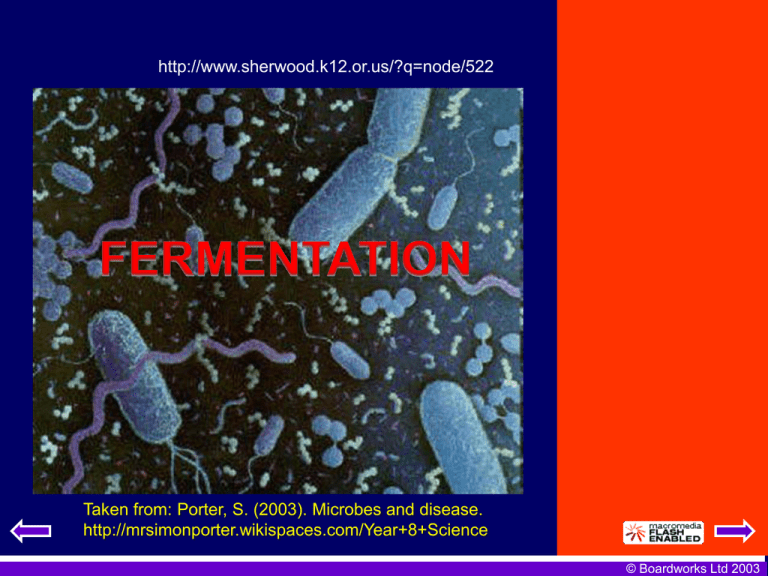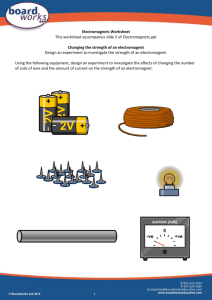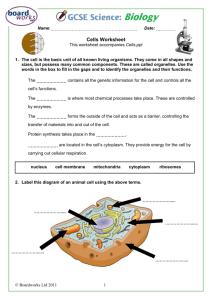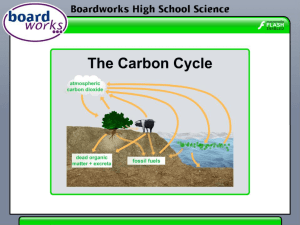Carbon dioxide + Water + Energy Cellular respiration
advertisement

http://www.sherwood.k12.or.us/?q=node/522 Taken from: Porter, S. (2003). Microbes and disease. http://mrsimonporter.wikispaces.com/Year+8+Science © Boardworks Ltd 2003 As the name suggests, MICROBES are microscopic organisms. They can only be seen using a microscope. © Boardworks Ltd 2003 Microbe can be put into a number of categories. The four types which you need to know about are listed below: BACTERIA VIRUS FUNGI PROTOZOA A living organism must be able to demonstrate that it can perform ALL the 7 life processes. Movement Respiration Sensitivity Growth Reproduction Excretion Nutrition © Boardworks Ltd 2003 Microbes multiply very rapidly. Two can, very quickly, become four then eight and so on. © Boardworks Ltd 2003 Microbe uses Microbes have many uses. This is mainly because we can ‘grow’ microbes if we wish to. Microbes (in this case bacteria) will grow in milk to make it ‘go off’. This is used in the yoghurt making process. Cheese is also another product made due to the use of microbes in industry. © Boardworks Ltd 2003 REVIEW of past concepts.... © Boardworks Ltd 2003 Chemical Energy and Food REVIEW of past concepts.... – Organisms get the energy they need from food. – Food molecules contain chemical energy that is released when its chemical bonds are broken © Boardworks Ltd 2003 Cellular respiration is the process that releases energy from food in the presence of oxygen. It happens in the mitochondria of the cell. REVIEW of past concepts.... – In symbols: 6 O2 + C6H12O6 6 CO2 + 6 H2O + Energy – In words: Oxygen + Glucose Carbon dioxide + Water + Energy © Boardworks Ltd 2003 Microbe uses Yeast is a microbe which RESPIRES to give off carbon dioxide. This is used in baking bread and in winemaking. We can use the AEROBIC respiration of yeast to make bread rise. Yeast uses the sugar in bread dough to respire. The reaction of CELL RESPIRATION (the same done for most of our cells in the mitochondria) is: Glucose + oxygen carbon + water + energy dioxide C6H12O6 + 6 O2 6 CO2 + 6 H2O + ATP The carbon dioxide given off causes the bread to rise. © Boardworks Ltd 2003 Microbe uses We can use the ANAEROBIC respiration of yeast to make beer and wine. This means that the yeast respires WITHOUT oxygen. This process produces alcohol (ethanol) and is known as FERMENTATION. Yeast converts the sugar into alcohol: carbon Glucose + ethanol + energy dioxide © Boardworks Ltd 2003 Virus A virus is a simple organism which does not completely display ALL the characteristics of living things. It consists of a protein coating and a strand of genes. © Boardworks Ltd 2003 Bacteria A bacteria is a single celled organism which does not completely have a nucleus. Their genes are found in the chromosomes. © Boardworks Ltd 2003 Fungus Yeast is a fungus and as can be seen below, it has a more complex structure than the other two types of microbes. © Boardworks Ltd 2003




